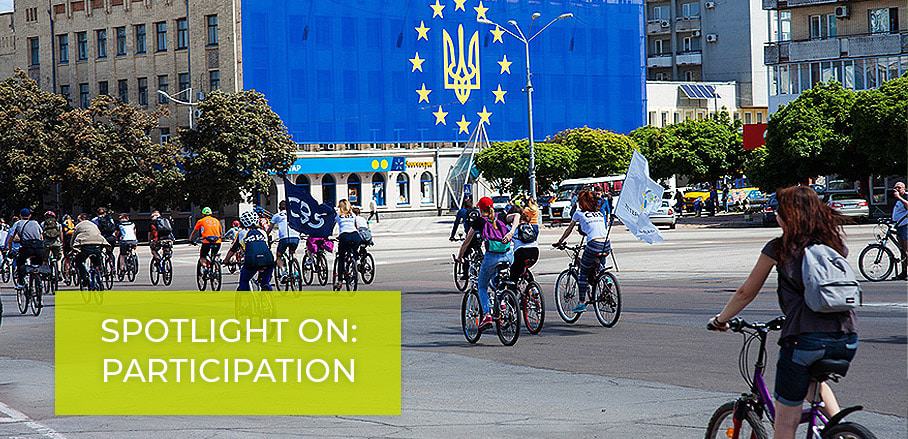Ukraine Towards Cycling
On its way towards becoming more sustainable, the Ukrainian capital of Kyiv is making plans to improve its cycling infrastructure. Natalya Tarnavchyk of GIZ Ukraine has talked to Kseniya Semenova of the Kyiv Cyclists’ Association about the city’s new cycling concept.
Over 20 Ukrainian cities have developed and are implementing strategies for improved bicycle traffic; the importance of cycling as an equal mode of transport is growing. German development cooperation has played a key role in making bicycles popular. GIZ supported Ukrainian cities in their first steps and worked together with numerous NGOs, city administrations, and activists to lobby for and inform about advantages and procedures of developing cycling infrastructure. In 2013, the first 15 km of cycle paths in accordance with European standards were built in the western Ukrainian city of Lviv. A range of practical guides and best practices in cycling strategy development has been developed. The Recommendations on Cycling Coordination by the Road and Transport Research Association were disseminated among interested city councils and cycling NGOs. In 2016, the first rent-a-bike system was established in Lviv. Eco-friendly means of transport will become full-fledged modes of transport in the cities of Zhytomyr, Poltava, Chernivtsi and Vinnytsia within the project “Integrated Urban Development in Ukraine” (GIZ).
In February 2018, the Ukrainian capital adopted a concept for the development of its cycling infrastructure. According to this concept, 240 km of cycle paths will be built in the upcoming five years. [inlinetweet prefix=”” tweeter=”” suffix=””]The long-term goal of this is the creation a network of 1,000 km of cycle paths covering the city of Kyiv, its green areas, and its links with major satellite towns.[/inlinetweet] For Ukraine, it means one more milestone in fully establishing bicycles as a mode of transport. What are the benefits this document has for the city, what impact will it have on the city’s public transport, which steps have been planned in order to promote cycling and who participated in concept development? Kseniya Semenova, head of the Kyiv Cyclists’ Association (AVK) and advisor to the Mayor of Kyiv for the development of the biking infrastructure, answers these questions in an interview with Natalya Tarnavchyk for URBANET.
Why does Kyiv Need a Master Plan for Cycling?
Kseniya Semenova: Cycle paths and pedestrian routes, in combination with a high-quality public transport system, help to establish a sustainable traffic environment. Studies prove that the promotion of cycling can contribute significantly to solving urban mobility problems. This can be seen in less traffic jams and widening mobility choices.
[inlinetweet prefix=”” tweeter=”” suffix=””]The cycling concept is a document that delivers a vision and propositions on how to integrate bicycles into the urban transport infrastructure.[/inlinetweet] As the concept’s main output we expect that out of the total number of trips made within the city, five per cent will be done by bicycles.
For a city with three million residents, such an increased number of cyclists would entail a number of benefits:
- Improved health among the residents of Kyiv;
- Better choice of the modes of transport; nowadays many people choose cars because they have no other options available;
- Green developments in tourism;
- Lower air pollution and lower noise level.
In terms of money, the development of the cycling infrastructure stands for a sensible use of the city budget. It is expected that the project’s cost of investment will be covered by its profits within less than one year. This is a great performance, as for transport infrastructure objects this time frame is usually expected to range between five and 15 years.
How Does the Concept Support Cycling? Which Measures Will Be Taken?
Kseniya Semenova: The cycling concept contains recommendations to engineers for the design of a safe and comfortable cycling infrastructure. These include for example the recommended width of a cycle lane or input on how to align a cycle path and a bus stop.
The concept designates space in all parts of Kyiv exclusively for cyclists: 240 km of priority cycle paths, forming the backbone of the cycling network, and more than 1,000 km of transport, recreational, and suburb routes for today’s and future cyclists. Maps of the cycling network have already been designed and are part of the concept. The map of priority cycle paths was prepared to identify routes that will have a priority funding in the upcoming years from the city budget. Cycle paths can already be designed and built in the first year of the concept’s implementation, since some of the cycle paths are covered by approved plans for the overhaul of streets and motorways.
How Have Citizens Been Involved in the Development of the Concept?
Kseniya Semenova: The cycling concept was developed by the municipal companies “Kyiv Centre for the Urban Development” and “Kyiv Investment Agency” with the support of the organisation “Kyiv Cyclists’ Association”, the NGOs “URBAN CURATORS” and “Centre for Society Research”, the Deutsche Gesellschaft für Internationale Zusammenarbeit (GIZ) and the company “А+S Ukraine”. The scheme of cycle paths was developed by the organisation “Kyiv Cyclists’ Association” in several stages. For this, we engaged international advisors, city administration employees, and cyclists from Kyiv. Also, residents of Kyiv, among them many active and potential cyclists as future users of the cycling infrastructure were involved in the design of the concept. A series of meetings initiated by the Kyiv Cyclists’ Association and later by the Department for Urban Development and Architecture ensured the real involvement of cyclists and the collection of information from them. That way the close involvement of citizens throughout the development of the concept has been ensured.
- Ukraine Towards Cycling - 6. June 2018
